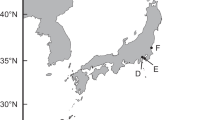Abstract.
Bioaccumulation of non-, mono-, and di-ortho–substituted chlorobiphenyls (CBs) was investigated in four species of mustelids (weasel, stoat, polecat, and otter) and their preys, from a restricted area in the northern part of The Netherlands. Diets of these mustelids ranged from terrestrial (weasel, stoat, and polecat) to aquatic (otter). Diet-specific biomagnification factors (BMFs), CB in diet relative to CB in mustelids, were calculated for the sum of 28 congeners (ΣCB), for the sum of the toxic equivalent concentration (ΣTEQ) and on an individual congener basis. Biotransformation was studied in relation to structural CB properties (vicinal H-atom substitution). In addition, the methylsulphonyl CB-metabolites were determined. The concentration of ΣCB on lipid weight basis increased in the order weasel < stoat < polecat < otter. On the basis of ΣTEQ, the order changed to weasel < polecat < stoat < otter. Most of the differences in BMFs between the CBs could be explained by the vicinal H-atom structure-activity rules. For all mustelids, the lowest BMFs were found for congeners with vicinal H-atoms in the meta, para position. Indications were found that all mustelid species can metabolize these congeners. For some of the CBs, their methylsulphonyl-CB metabolites were determined and found to be present in concentrations up to 350-fold higher than those of the parent compounds. In addition, the non-ortho CBs 126 and 169 are selectively retained in the liver of weasel, stoat, and otter. These CBs had the highest BMFs of all congeners. However, rather surprisingly, in polecat the highest BMFs were found for di-ortho–substituted CBs. This animal was able to metabolize all congeners with vicinal H-atoms in the ortho and meta position (non- and mono-ortho CBs). The information concerning the differences in bioaccumulation of CBs for closely related mustelid species increased the understanding of reported differences in PCB toxicity between mink and ferrets, and suggest that weasel, stoat, and otter are at least as sensitive to CBs as are mink, while polecats are less sensitive. As otter is exposed to much higher concentrations of CBs trough their diet than weasel and stoat, the toxic threat of CBs will be the greatest for this animal.
Similar content being viewed by others
Author information
Authors and Affiliations
Additional information
Received: 10 February 1998/Accepted: 6 July 1998
Rights and permissions
About this article
Cite this article
Leonards, P., Broekhuizen, S., de Voogt, P. et al. Studies of Bioaccumulation and Biotransformation of PCBs in Mustelids Based on Concentration and Congener Patterns in Predators and Preys. Arch. Environ. Contam. Toxicol. 35, 654–665 (1998). https://doi.org/10.1007/s002449900428
Issue Date:
DOI: https://doi.org/10.1007/s002449900428




